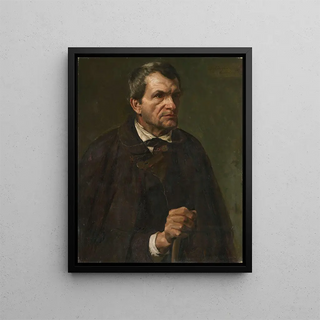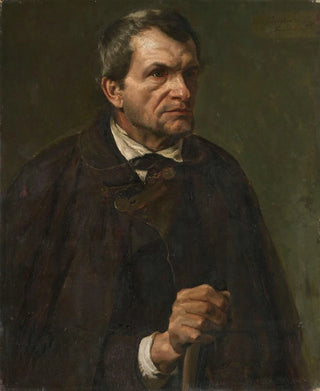Art print | Study of the farmer Florian Killian figure - Eilif Peterssen


View from behind

Frame (optional)
In the vast panorama of art history, certain works stand out for their ability to capture the very essence of humanity. "Art print of the farmer Florian Killian" by Eilif Peterssen fits perfectly into this tradition. This piece, rooted in the realism movement, transports us to the heart of rural life, revealing the beauty and dignity of fieldwork. Through this study, Peterssen does not merely depict a man at work; he evokes a story, a culture, and a way of life deeply embedded in the Norwegian landscape. The artist succeeds in establishing a dialogue between the viewer and the subject, inviting everyone to reflect on the relationship between man and land.
Style and uniqueness of the work
Eilif Peterssen's work is characterized by a meticulous approach and particular attention to detail. In "Art print of the farmer Florian Killian," the artist uses a palette of earthy colors that evoke the surrounding nature, while highlighting the features of the farmer. The posture of the character, both robust and humble, demonstrates a quiet strength, symbolizing rural life. Peterssen skillfully plays with light and shadow, creating an intimate atmosphere that allows the viewer to immerse themselves in the farmer's universe. This striking realism, combined with palpable sensitivity, makes this piece a true masterpiece capable of touching the hearts of those who observe it.
The artist and his influence
Eilif Peterssen, Norwegian painter of the 19th century, is often regarded as one of the pioneers of naturalism in Scandinavia. His training, marked by influences both classical and contemporary, enabled him to develop a unique style, blending technical precision with profound humanity. Peterssen absorbed the artistic currents of his time while remaining faithful to his Norwegian roots. His work, rich in emotion and reflections on the human condition, paved the way for many artists who sought to depict daily life with unprecedented authenticity. His commitment to the representation of rural life

Matte finish

View from behind

Frame (optional)
In the vast panorama of art history, certain works stand out for their ability to capture the very essence of humanity. "Art print of the farmer Florian Killian" by Eilif Peterssen fits perfectly into this tradition. This piece, rooted in the realism movement, transports us to the heart of rural life, revealing the beauty and dignity of fieldwork. Through this study, Peterssen does not merely depict a man at work; he evokes a story, a culture, and a way of life deeply embedded in the Norwegian landscape. The artist succeeds in establishing a dialogue between the viewer and the subject, inviting everyone to reflect on the relationship between man and land.
Style and uniqueness of the work
Eilif Peterssen's work is characterized by a meticulous approach and particular attention to detail. In "Art print of the farmer Florian Killian," the artist uses a palette of earthy colors that evoke the surrounding nature, while highlighting the features of the farmer. The posture of the character, both robust and humble, demonstrates a quiet strength, symbolizing rural life. Peterssen skillfully plays with light and shadow, creating an intimate atmosphere that allows the viewer to immerse themselves in the farmer's universe. This striking realism, combined with palpable sensitivity, makes this piece a true masterpiece capable of touching the hearts of those who observe it.
The artist and his influence
Eilif Peterssen, Norwegian painter of the 19th century, is often regarded as one of the pioneers of naturalism in Scandinavia. His training, marked by influences both classical and contemporary, enabled him to develop a unique style, blending technical precision with profound humanity. Peterssen absorbed the artistic currents of his time while remaining faithful to his Norwegian roots. His work, rich in emotion and reflections on the human condition, paved the way for many artists who sought to depict daily life with unprecedented authenticity. His commitment to the representation of rural life






